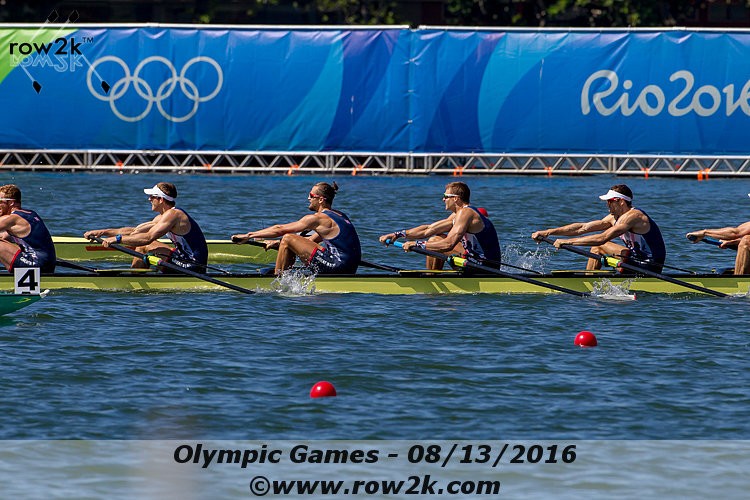
One of the comments I most like to hear from a student as they adapt to our style is "But that's too easy!" - exactly the point we're trying to make. Don't fight the oar or the boat, don't fight your body, do what feels right. Occasionally we'll have a young kid come row with us, 10 or 11 years old. They're completely bored with our dock talks and video but they get in the boat and make it look easy. They want it to be fun. As adults, we're rowing for exercise so we think we need to put more, not less, effort into every stroke. We want you to step back, take a deep breath and relax.
Let's start with the grip and the arms. Use your fingers to hook around the oar handle on the drive, keeping your palm off the oar.

Allow your arms to relax and hang off the oar. Don't lock your elbows at any point in the stroke.

The lats are the muscles you want to connect to (see the photo at the top of this article), but if your arms are stiff, you'll end up connecting to your traps. These little muscles might make you feel like you're working hard but you won't be working effectively.
If you're new to the single, don't worry about getting your blades off the water. Keep your hands neutral on the oar, don't lift up, don't push down. Oars are designed such that the blade when square will float just below the surface, and when feathered will skim right across the water. Let the oar tell you where it wants to go, don't force it. The hands should move as if they're on a narrow conveyor belt - straight across the top (the drive), a small roller at either end (the catch and the release), straight across the bottom (the recovery).
There is very little difference in the height of the hands between the recovery and the drive. So instead of lifting the oar handle at the catch, unweight the hands and let gravity drop the blade in. At the finish, let just the top edge of the blade come out of the water, then feather the blade with thumb and fingers, not wrist and elbows. When done right, the blade will slip out of the water, not wrench out. As you get better, you'll make a slightly larger loop to get the blades off the water but even then, don't make blades off the water the be all and end all.
Second, and just as important, is relaxing the body, which often comes down to posture. Coxswains and coaches love to tell their rowers to sit tall, chest out, good posture. Not only does this tend to make you stiff, but it will bring a vertical component into a horizontal sport. We're looking for you to relax the body. Sit back at the finish as if you're lying back on a bean bag chair (Photo #4), roll your pelvis back and don't stay on those sit bones.

Try sitting on the floor and leaning back as far as you can while staying on your sit bones. You'll find it takes a lot of abdominal strength to hold that position and you won't be able to go back that far. Now relax, and roll your pelvis down, rolling onto your back pockets so to speak. In this position, you could hang out all day. An added advantage is you'll be lower in the boat, a more stable position.

As you roll out of the bow, keep your head level and your back rounded, right up into the catch.


Depending on the natural curvature of your back, not everyone will look alike, just allow yourself to sit comfortably, stay relaxed and loose.

While many people talk "sit up", just look at photos and video of any elite rower, they are not sitting up.


So relax. Rowing will be demanding enough once you start trying to go fast, no need to make it hard where it doesn't need to be.
If you enjoy and rely on row2k, we need your help to be able to keep doing all this. Though row2k sometimes looks like a big, outside-funded operation, it mainly runs on enthusiasm and grit. Help us keep it coming, thank you! Learn more.
Comments | Log in to comment |
There are no Comments yet
| |
- Bont Rowing
- Calm Waters Rowing
- Concept 2
- Craftsbury Sculling
- The Crew Classic
- CrewLAB
- Croker
- Durham Boat Co.
- Empacher
- Faster Masters
- Filippi
- Fluidesign
- h2row.net
- HUDSON
- Live2Row Studios
- Nielsen-Kellerman
- Oak Ridge RA
- Peinert Boat Works
- Pocock Racing Shells
- Race1 USA
- RowKraft
- Rubini Jewelers
- Vespoli USA
- WinTech Racing
- Bont Rowing
- Calm Waters Rowing
- Concept 2
- Craftsbury Sculling
- The Crew Classic
- CrewLAB
- Croker
- Durham Boat Co.
- Empacher
- Faster Masters
- Filippi
- Fluidesign
- h2row.net
- HUDSON
- Live2Row Studios
- Nielsen-Kellerman
- Oak Ridge RA
- Peinert Boat Works
- Pocock Racing Shells
- Race1 USA
- RowKraft
- Rubini Jewelers
- Vespoli USA
- WinTech Racing

















